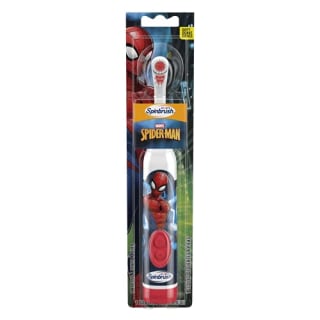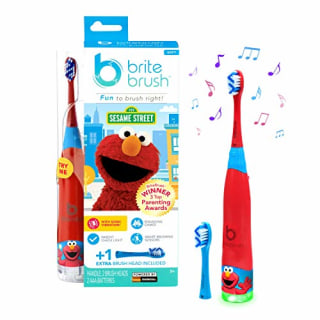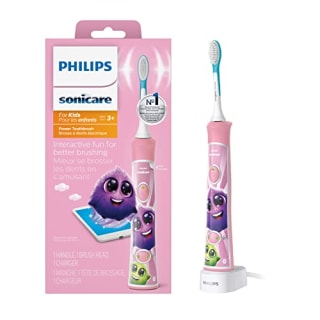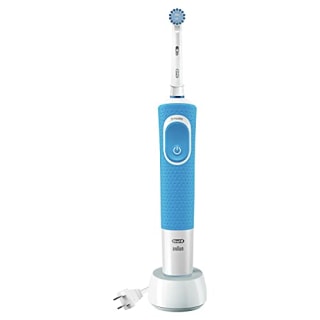Pediatric dentists say that taking care of your child’s oral health should start early on: As soon as baby teeth start to come in, parents should brush their child’s teeth at least twice a day using a soft-bristled, age-appropriate toothbrush and toothpaste, according to the American Academy of Pediatric Dentistry (AAPD). Parents can use a manual toothbrush, or they can opt for an electric toothbrush, which experts told us is a fun and effective way to teach children how to appropriately brush their teeth.
SKIP AHEAD Best kids electric toothbrushes | How to shop for kids electric toothbrushes | Pros and cons of kids electric toothbrushes | When can kids use an electric toothbrush? | Best practices for using kids electric toothbrushes
We spoke to pediatric dentists about the benefits of electric toothbrushes for kids and how to safely use one. We also highlighted some highly rated and expert-recommended electric toothbrushes for kids that have the American Dental Association Seal of Acceptance.
Our top picks
- Best budget pick: Arm & Hammer Kid’s Spinbrush Electric Toothbrush
- Best smart feature-equipped pick: Philips Sonicare for Kids
- Best kids electric toothbrush subscription: Quip Kids Electric Toothbrush
How we picked the best kids electric toothbrushes
While shopping for kids electric toothbrushes, experts said to consider the following factors:
ADA Seal of Acceptance, which means the brand submitted data and other materials to the ADA and the organization determined that the product meets specified safety and efficacy requirements. However, this does not mean electric toothbrushes without the ADA Seal of Acceptance are ineffective — it just means brands have not voluntarily submitted their products for the ADA to review.
Kid-friendly design elements like images of animated characters to encourage children to brush their teeth
Built-in timers to ensure kids brush for the recommended two minutes
Age recommendations listed on packaging
Type of electric toothbrush, including rotating (head spins continuously in one direction), oscillating (back and forth motion) or sonic (high-speed vibrations).
Cost to help you zero in on budget picks versus pricier options, which usually have more interactive features
Best kids electric toothbrushes to shop in 2023
Below, we list some highly rated and expert-recommended kids electric toothbrushes that align with our research and note if they sport the ADA Seal of Acceptance.
Quip Kids Electric Toothbrush
Quip’s kids electric toothbrush has a rubber grip handle and comes with a travel cover that doubles as a mirror mount. The toothbrush’s replaceable battery lasts up to three months, the brand says, and Quip offers a replacement brush head with a free battery refill for $5, which can be purchased separately or through a 3-month subscription plan. The electric toothbrush is available in four colors: Purple, Green, Pink and Blue.
ADA Seal of Acceptance: Yes | Type: Sonic | Battery: AAA batteries | Timer: Yes | Age recommendation: 3 and older
This budget-friendly oscillating-rotating toothbrush from Arm & Hammer is a manual and electric hybrid — it has fixed lower bristles and oscillating upper bristles to clean dental plaque between teeth, according to the brand. The brush comes in a variety of kid-friendly designs, including superheroes, Super Mario and Paw Patrol.
ADA Seal of Acceptance: Yes | Type: Oscillating | Battery: AAA batteries | Timer: No | Age recommendation: 3 and older
BriteBrush Sesame Street Electric Toothbrush
BriteBrush offers several electric toothbrushes for kids with fun designs, including “Sesame Street,” “Baby Shark” and GameBrush. All of the toothbrushes let kids play games and music. They also have a replacement brush head and a Parent Check Light that shows a red, yellow or green light to indicate how well your child brushes, according to the brand. The Sesame Street and Baby Shark brushes are recommended for children 3 and older, while the GameBrush, which features up to 7 games, is designed for kids 5 and older.
ADA Seal of Acceptance: No | Type: Sonic | Battery: AAA batteries | Timer: Yes | Age recommendation: Varies per brush
Philips Sonicare For Kids
Dr. Travis Nelson, associate professor and chair of the department of pediatric dentistry at the University of Washington, recommended this Philips toothbrush due to its easy-to-hold handle, kid-friendly cartoon design and interactive smartphone app that the brand says coaches kids on how to brush with fun animations and rewards. The brush has a rubber grip on the handle, a slim ergonomic design and two power modes to control intensity, according to Philips
ADA Seal of Acceptance: No | Type: Sonic | Battery: Rechargeable | Timer: Yes | Age recommendation: 4 and older
Oral-B Supertooth Kids Electric Toothbrush Bundle
Oral-B offers a variety of kids electric toothbrushes — which Nelson also recommended — that include animated characters in popular kids films, ranging from Spider-Man and Star Wars to “Moana” and “Frozen.” The brand says this brush is designed with a soft grip handle, along with a built-in timer to help kids reach the recommended two minutes.
ADA Seal of Acceptance: No | Type: Rotating | Battery: Rechargeable | Timer: Yes | Age recommendation: Sensitive brush head suitable for kids 3 and older
How to shop for an electric toothbrush for kids
Below are a few factors experts recommended thinking about while deciding which kids electric toothbrush to purchase.
ADA Seal of Acceptance
Many of the experts we spoke to recommend buying electric toothbrushes that earned the ADA Seal of Acceptance, which is “an indication that the toothbrush has demonstrated safety and efficacy,” according to Dr. Breno Reboucas, clinical associate professor of pediatric dentistry at Boston University. The Seal is awarded for a period of five years and products must meet standards evaluated by a team of scientists in fields like microbiology, pharmacology, toxicology and chemistry, according to the ADA.
However, remember that the ADA’s list is not exhaustive. Nelson said he doesn’t worry too much about the ADA Seal of Acceptance when it comes to long-standing, high-quality brands like Philips and Oral-B due to their durability and performance.
Type of electric toothbrush
Just like adult electric toothbrushes, powered toothbrushes for kids come in varying types depending on how the bristles and brush head move. Dr. Kimberly K. Patterson, interim chair of the Department of Orthodontics and Pediatric Dentistry at Stony Brook School of Dental Medicine, mentioned there are three main types of electric toothbrushes:
A rotating electric toothbrush features a brush head that spins continuously in one direction
An oscillating toothbrush moves back and forth (combination oscillating-rotating electric toothbrushes are popular options)
A sonic toothbrush equips a brush head that vibrates at a high speed
Generally, all types of electric toothbrushes increase the number of brush strokes per minute and can therefore increase efficiency compared to manual toothbrushes, Nelson said. While some studies suggest that sonic and ultrasonic toothbrushes — which vibrate at an even higher frequency — can be better at removing dental plaque than rotating brushes in adults, there isn’t enough data to suggest that one type of movement is more effective than the other for children, said Dr. Vineet Dhar, clinical professor and chair of orthodontics and pediatric dentistry at the University of Maryland. Ultimately, the choice comes down to what a child feels most comfortable with, experts said.
Interactive features and kid-friendly designs
To encourage kids to brush their teeth, many brands offer kid-friendly designs with popular animated characters, animals and more. Experts also recommended looking out for interactive features to engage children while brushing, including music, timers, built-in rewards and app-controlled settings.
The experts we spoke to all recommended electric toothbrushes with timers, which allow kids to best reach the recommended two minutes of brushing. Dr. Cristina Perez, associate professor and chief of the division of pediatric dentistry at the University of Kentucky, noted some brushes will pulsate to “tell kids when to go to the other side of the mouth,” while others will play music or simply shut off when two minutes have passed. For older children, Dhar recommended brushes with a pressure sensor to ensure “they aren’t putting too much pressure on their teeth while brushing.”
Ease of use
In general, “any electric toothbrush with a small head, soft bristles and an easy grip may help with better control and reach within the mouth especially while cleaning the back teeth,” Dhar said. To figure out the right head size, Perez recommended parents pay close attention to the toothbrush’s age recommendations.
If you want the bristles to be even softer, she advised running the brush head under hot water before each use.
Cost
Experts agreed that the more interactive an electric toothbrush is, the more expensive it’ll likely be. Nelson, who recommended rechargeable toothbrushes with built-in timers, said good quality electric toothbrushes with these features, as well as those that can connect to a smartphone app, will typically cost around $30 to $50. However, some of the ADA-approved kids electric toothbrushes are under $20 and come with basic features like musical timers and kid-friendly designs.
Pros and cons of kids electric toothbrushes
The pediatric dentists we spoke to noted there are a variety of benefits to switching your child’s toothbrush to a powered one. However, you should still be aware of their limitations before making the switch, especially if you have younger children.
Pros
Experts said powered brushing creates microbubbles that gently remove bacteria from teeth. In fact, a recent small clinical study showed powered brushes were more effective at removing plaque than manual brushes both when parents brushed for children ages 3 to 6 and when children ages 7 to 9 brushed themselves — however, Patterson told us that both a manual and powered toothbrush can ultimately get the job done. Electric toothbrushes can also add a little more excitement to the routine brushing process with features like music and blinking lights, Patterson said.
Cons
Keep in mind that electric toothbrushes can be slightly more intimidating, especially for younger children. Both Patterson and Nelson noted children with sensory sensitivity, those on the autism spectrum and those who experience migraines or have cochlear implants may find powered toothbrushes too stimulating.
When can kids use an electric toothbrush?
The AAPD does not have a recommendation regarding the age at which a child can begin to use a powered toothbrush. However, our experts generally recommend using manual brushes with children until they are at least 3 years old and said parents or guardians should help a child with brushing until age 7, typically around the time their adult molars have erupted.
Best practices for using kids electric toothbrushes
Much like a manual toothbrush, electric brushes are only beneficial if they’re used correctly. Reboucas recommended “positioning the toothbrush at a 45-degree angle [and] not putting too much pressure” to ensure efficacy. It’s also important to note that brush heads should be changed out regularly. Parents should replace the brush head of their child’s electric toothbrush after about three months of use since bristles can wear down and become “less effective in removing dental plaque,” Patterson said.
Remember that a toothbrush is only one part of a child’s oral hygiene routine. Experts emphasized that children who use either a manual or electric toothbrush with a fluoridated toothpaste twice a day are less likely to develop tooth decay and cavities (the AAPD suggests children under the age of 3 use a “smear” of toothpaste smaller than a grain of rice).
Meet our experts
At Select, we work with experts who have specialized knowledge and authority based on relevant training and/or experience. We also take steps to ensure that all expert advice and recommendations are made independently and with no undisclosed financial conflicts of interest.
Dr. Travis Nelson is the associate professor and chair of the department of pediatric dentistry at the University of Washington.
Dr. Kimberly K. Patterson is the interim chair of the Department of Orthodontics and Pediatric Dentistry at Stony Brook School of Dental Medicine, as well as the program director of the advanced education program in pediatric dentistry.
Dr. Vineet Dhar is a clinical professor and chair of orthodontics and pediatric dentistry at the University of Maryland.
Dr. Cristina Perez is an associate professor and chief of the division of pediatric dentistry at the University of Kentucky.
Dr. Breno Reboucas is a clinical associate professor of pediatric dentistry at Boston University.
Why trust Select?
Mili Godio is an editor at Select who has covered a variety of children’s wellness topics, including sunscreens, bikes and rolling backpacks. For this piece, Godio interviewed five experts and researched dozens of electric toothbrushes for kids on the market. We included five products recommended by pediatric dentists.
Catch up on Select's in-depth coverage of personal finance, tech and tools, wellness and more, and follow us on Facebook, Instagram and Twitter to stay up to date.












